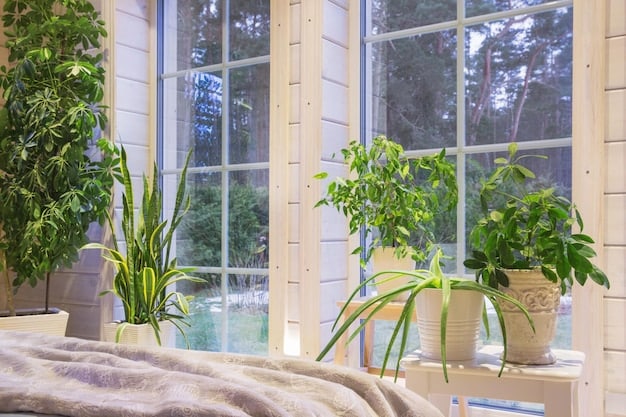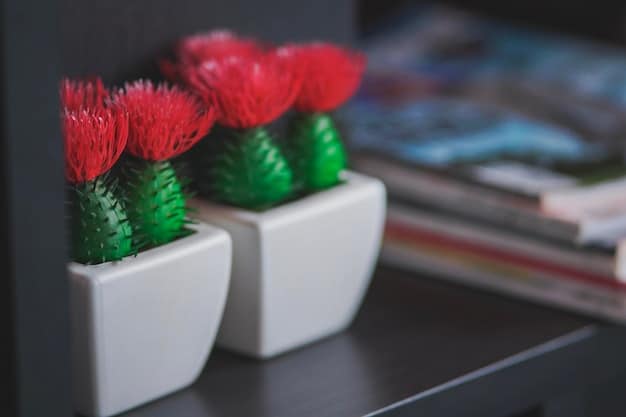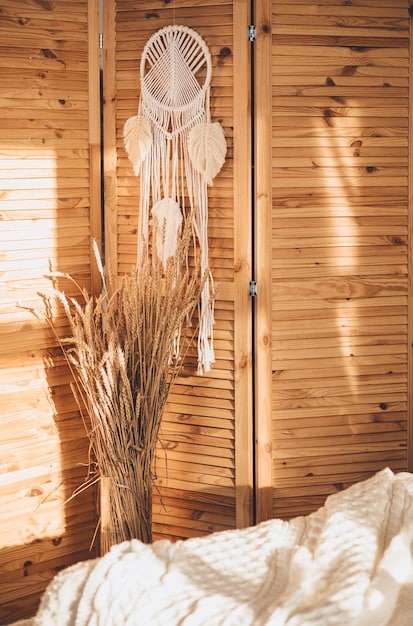Biophilic Design: 5 Ways to Bring Nature Home

Biophilic design integrates natural elements into your home, creating a calming atmosphere by fostering a connection with the outdoors, improving well-being and reducing stress through natural light, plants, and organic materials.
Bring the tranquility of nature into your living space with biophilic design. Discover 5 ways to incorporate biophilic design into your home for a calming atmosphere, enhancing your well-being and creating a serene environment.
5 Ways to Incorporate Biophilic Design at Home
Biophilic design, at its core, is about reconnecting us with nature within our built environments. It’s a design philosophy that recognizes our innate need to affiliate with the natural world, and seeks to integrate natural elements and patterns into our homes and workplaces.
Incorporating biophilic design isn’t just about aesthetics; it’s about creating spaces that support our mental and physical health. Studies have shown that biophilic design can reduce stress, improve cognitive function, and enhance creativity. Let’s explore five impactful ways to bring this natural harmony into your home.

Embrace Natural Light and Ventilation
Natural light and ventilation are foundational elements, and are key to biophilic design. They not only make a space feel more inviting, but also play a crucial role in regulating our circadian rhythms and overall well-being.
Maximizing these elements in your home can be achieved through simple adjustments and thoughtful design choices. Aim to create an environment where natural light and fresh air are abundant and easily accessible.
Optimize Natural Light
One of the most effective ways to enhance natural light is by decluttering windows and using light-colored window coverings. Mirrors strategically placed can also amplify the light, bouncing it around the room.
Enhance Natural Ventilation
Proper ventilation ensures a steady supply of fresh air, reducing indoor pollutants and promoting a healthier environment. Open windows regularly, even for short periods, to circulate air and reduce stuffiness.
- Install Large Windows: Maximize natural light intake with larger windows.
- Use Light-Colored Curtains: Opt for sheer or light-colored curtains to allow ample light.
- Add Skylights: Consider skylights to introduce overhead natural light.
- Improve Cross Ventilation: Ensure fresh air circulation by opening windows on opposite sides of the room.
By prioritizing natural light and ventilation, you’ll create a home that feels more connected to the outdoors, fostering a sense of calm and vitality. These principles make a noticeable difference in how you experience your living space.
Introduce Indoor Plants and Greenery
Plants are perhaps the most recognizable element of biophilic design. They bring life, color, and texture into our homes, creating a visual connection with nature that can be incredibly soothing.
Beyond their aesthetic appeal, plants also offer tangible health benefits, improving air quality and helping to regulate humidity levels. Choosing the right plants can transform any room into a tranquil haven.
Selecting the Right Plants
When selecting plants, consider the light conditions and humidity levels of your home. Low-maintenance options like snake plants, ZZ plants, and spider plants are excellent choices for beginners. For brighter spaces, consider ferns, succulents, or even small fruit trees.
Creative Plant Displays
Think beyond traditional potted plants. Vertical gardens, hanging planters, and terrariums are all creative ways to incorporate greenery into your space. Grouping plants together can also create a mini indoor ecosystem, enhancing their visual impact and health benefits.
- Choose Various Plant Types: Use various textures and colors to mimic natural ecosystems.
- Create Vertical Gardens: Maximize space with wall-mounted plant displays.
- Hang Plants: Suspend plants from ceilings or walls for a dynamic look.
- Grow Herbs Indoors: Add functional greenery with culinary herbs in the kitchen.
Introducing indoor plants and greenery is a simple yet effective way to incorporate biophilic design into your home. The presence of plants not only enhances the aesthetic appeal of your space, but also contributes to a healthier and more calming atmosphere, bringing the benefits of nature indoors.
Use Natural Materials and Textures
Incorporating natural materials and textures is crucial for creating a biophilic design that resonates with our senses. These materials evoke a sense of connection to the earth, fostering warmth, comfort, and a feeling of grounding.
From wood and stone to cotton and wool, these elements can transform a space, making it feel more organic and inviting. Let’s explore how to integrate them thoughtfully into your home.

Wood Elements
Wood is a versatile material that can be used in flooring, furniture, and decorative accents. Its natural grain and warmth create a welcoming atmosphere. Opt for reclaimed wood or sustainably sourced options to further enhance the biophilic appeal.
Stone and Earth Tones
Stone and earth tones bring a sense of stability and permanence to a space. Use these materials in flooring, countertops, or accent walls to create a grounding effect. Incorporating colors inspired by nature, such as greens, browns, and blues, can further enhance the connection to the outdoors.
- Install Wood Flooring: Choose hardwood or bamboo for natural warmth.
- Add Stone Accents: Incorporate stone fireplaces or countertops.
- Use Natural Textiles: Opt for linen, cotton, and wool in upholstery and bedding.
- Introduce Rattan and Wicker: Add texture with rattan furniture or wicker baskets.
By incorporating natural materials and textures, you can create a home that feels more connected to the earth, promoting a sense of calm and well-being. This approach to design transforms your space into a sanctuary, mirroring the balance and harmony found in the natural world.
Incorporate Water Features and Sounds
Water is a powerful element that can bring tranquility and movement into a space. The sound of running water is inherently soothing, helping to reduce stress and create a calming atmosphere.
Introducing water features and sounds can be achieved in various ways, from simple additions to more elaborate installations. Let’s explore how to seamlessly integrate these elements into your home.
Small Water Fountains
Small indoor fountains are a great way to introduce the sound of water without requiring significant space or installation. These fountains can be placed on tabletops or shelves, creating a focal point that promotes relaxation.
Aquariums and Ponds
For a more immersive experience, consider an aquarium or a small indoor pond. The movement of fish and the gentle sound of water can be incredibly calming and captivating. Ensure that the aquarium or pond is well-maintained to promote a healthy environment.
- Add a Tabletop Fountain: Introduce the soothing sound of running water.
- Install a Wall Fountain: Create a visually stunning water feature.
- Create a Small Indoor Pond: Bring nature indoors with aquatic plants and fish.
- Play Nature Soundscapes: Use recordings of water sounds for relaxation.
By incorporating water features and sounds, you can transform your home into a peaceful retreat, promoting a sense of calm and well-being. The presence of water not only enhances the aesthetic appeal of your space, but also contributes to a more soothing and harmonious environment, reflecting the natural balance of the world.
Create a Visual Connection with Nature
Establishing a visual connection with nature is a cornerstone of biophilic design. Even if you live in an urban environment, there are numerous ways to create a sense of connection with the outdoors through thoughtful design choices.
These visual cues can significantly impact your well-being, fostering a sense of tranquility and connection to the natural world. Let’s explore how to enhance this visual link in your home.
Large Windows and Views
If possible, maximize views of the outdoors with large windows. Frame scenes of nature, such as trees, gardens, or water features. If your view is limited, consider creating a small outdoor garden or balcony to enhance the connection.
Nature-Inspired Art
Incorporate art that depicts natural landscapes, plants, or animals. These images can evoke a sense of calm and wonder, reminding us of the beauty of the natural world. Choose pieces that resonate with you and complement your décor.
- Install Large Windows: Frame views of the outdoors.
- Use Nature-Inspired Art: Hang paintings or photographs of landscapes.
- Create a Balcony Garden: Cultivate a small outdoor space with plants.
- Add Natural Patterns: Incorporate patterns inspired by nature in fabrics and wallpapers.
By creating a visual connection with nature, you can transform your home into a sanctuary, promoting a sense of calm and well-being. These visual cues remind us of the beauty and harmony of the natural world, helping us to feel more grounded and connected in our daily lives.
| Key Point | Brief Description |
|---|---|
| ☀️ Natural Light | Maximize daylight with large, clear windows. |
| 🪴 Indoor Plants | Introduce various plants for cleaner air and calmness. |
| 🪵 Natural Materials | Use wood, stone, and natural fibers for warmth. |
| 🌊 Water Features | Add fountains or aquariums for soothing sounds. |
Frequently Asked Questions
▼
Biophilic design is an architectural approach that seeks to connect building occupants more closely to nature by incorporating natural elements and processes into the built environment. It leverages our innate affinity for the natural world to improve well-being.
▼
It enhances mental and physical health by reducing stress, improving cognitive function, and boosting creativity. It also promotes a sense of calm and connection, fostering a more productive and comfortable living or working environment.
▼
Opt for low-light plants like snake plants, ZZ plants, or pothos. Alternatively, use grow lights to supplement natural light and ensure your plants receive adequate illumination. Rotate plants occasionally to provide even exposure.
▼
Use natural light effectively by cleaning windows, incorporate free natural elements like stones or branches, propagate plants from cuttings, and rearrange your furniture to maximize views of nature. These simple adjustments create impact.
▼
Water features introduce soothing sounds and visuals that reduce stress and promote relaxation. They also help humidify the air, improving air quality and creating a more comfortable indoor environment, especially in dry climates or during winter.
Conclusion
Integrating biophilic design into your home is a powerful way to enhance your living space and improve your well-being. By prioritizing natural light, incorporating plants, using natural materials, introducing water features, and creating visual connections with nature, you can transform your home into a calming and rejuvenating sanctuary. Embrace these principles and enjoy the many benefits of bringing the outdoors in.





